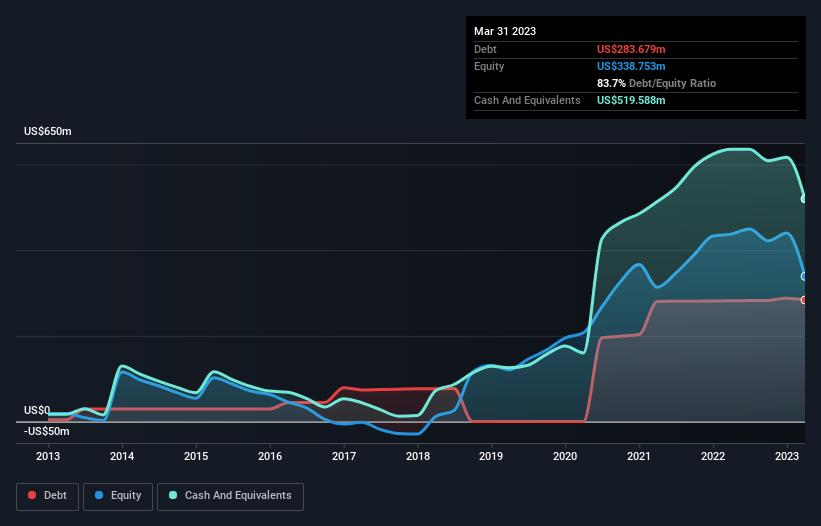- United States
- /
- Medical Equipment
- /
- NasdaqGM:TNDM
Is Tandem Diabetes Care (NASDAQ:TNDM) Using Debt Sensibly?

Some say volatility, rather than debt, is the best way to think about risk as an investor, but Warren Buffett famously said that 'Volatility is far from synonymous with risk.' When we think about how risky a company is, we always like to look at its use of debt, since debt overload can lead to ruin. We note that Tandem Diabetes Care, Inc. (NASDAQ:TNDM) does have debt on its balance sheet. But is this debt a concern to shareholders?
What Risk Does Debt Bring?
Debt assists a business until the business has trouble paying it off, either with new capital or with free cash flow. If things get really bad, the lenders can take control of the business. However, a more usual (but still expensive) situation is where a company must dilute shareholders at a cheap share price simply to get debt under control. Of course, debt can be an important tool in businesses, particularly capital heavy businesses. When we examine debt levels, we first consider both cash and debt levels, together.
See our latest analysis for Tandem Diabetes Care
How Much Debt Does Tandem Diabetes Care Carry?
The chart below, which you can click on for greater detail, shows that Tandem Diabetes Care had US$283.7m in debt in March 2023; about the same as the year before. But it also has US$519.6m in cash to offset that, meaning it has US$235.9m net cash.

A Look At Tandem Diabetes Care's Liabilities
The latest balance sheet data shows that Tandem Diabetes Care had liabilities of US$171.2m due within a year, and liabilities of US$444.2m falling due after that. Offsetting this, it had US$519.6m in cash and US$91.4m in receivables that were due within 12 months. So its total liabilities are just about perfectly matched by its shorter-term, liquid assets.
This state of affairs indicates that Tandem Diabetes Care's balance sheet looks quite solid, as its total liabilities are just about equal to its liquid assets. So it's very unlikely that the US$1.67b company is short on cash, but still worth keeping an eye on the balance sheet. Despite its noteworthy liabilities, Tandem Diabetes Care boasts net cash, so it's fair to say it does not have a heavy debt load! The balance sheet is clearly the area to focus on when you are analysing debt. But ultimately the future profitability of the business will decide if Tandem Diabetes Care can strengthen its balance sheet over time. So if you want to see what the professionals think, you might find this free report on analyst profit forecasts to be interesting.
In the last year Tandem Diabetes Care wasn't profitable at an EBIT level, but managed to grow its revenue by 7.7%, to US$795m. That rate of growth is a bit slow for our taste, but it takes all types to make a world.
So How Risky Is Tandem Diabetes Care?
We have no doubt that loss making companies are, in general, riskier than profitable ones. And the fact is that over the last twelve months Tandem Diabetes Care lost money at the earnings before interest and tax (EBIT) line. Indeed, in that time it burnt through US$33m of cash and made a loss of US$204m. Given it only has net cash of US$235.9m, the company may need to raise more capital if it doesn't reach break-even soon. Overall, we'd say the stock is a bit risky, and we're usually very cautious until we see positive free cash flow. There's no doubt that we learn most about debt from the balance sheet. But ultimately, every company can contain risks that exist outside of the balance sheet. Case in point: We've spotted 1 warning sign for Tandem Diabetes Care you should be aware of.
Of course, if you're the type of investor who prefers buying stocks without the burden of debt, then don't hesitate to discover our exclusive list of net cash growth stocks, today.
Valuation is complex, but we're here to simplify it.
Discover if Tandem Diabetes Care might be undervalued or overvalued with our detailed analysis, featuring fair value estimates, potential risks, dividends, insider trades, and its financial condition.
Access Free AnalysisHave feedback on this article? Concerned about the content? Get in touch with us directly. Alternatively, email editorial-team (at) simplywallst.com.
This article by Simply Wall St is general in nature. We provide commentary based on historical data and analyst forecasts only using an unbiased methodology and our articles are not intended to be financial advice. It does not constitute a recommendation to buy or sell any stock, and does not take account of your objectives, or your financial situation. We aim to bring you long-term focused analysis driven by fundamental data. Note that our analysis may not factor in the latest price-sensitive company announcements or qualitative material. Simply Wall St has no position in any stocks mentioned.
About NasdaqGM:TNDM
Tandem Diabetes Care
A medical device company, designs, develops, and commercializes technology solutions for people living with diabetes in the United States and internationally.
Adequate balance sheet and fair value.
Similar Companies
Market Insights
Community Narratives




